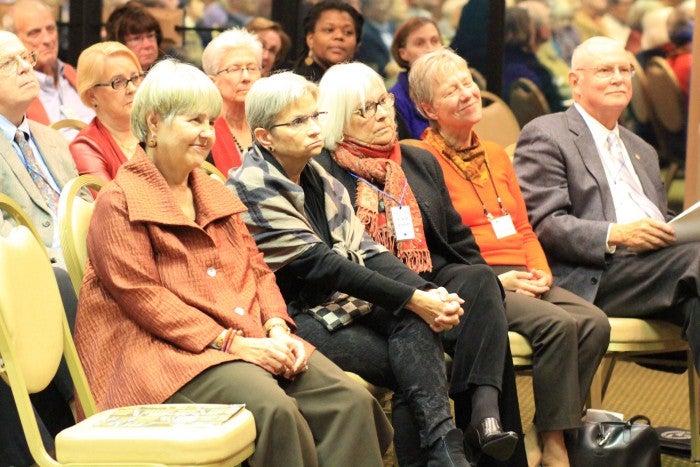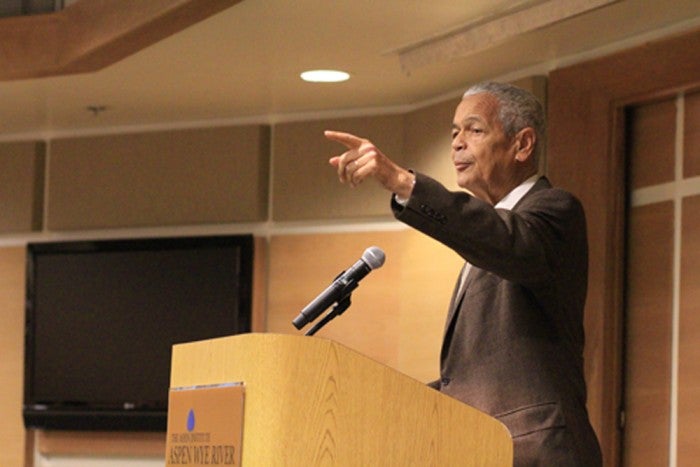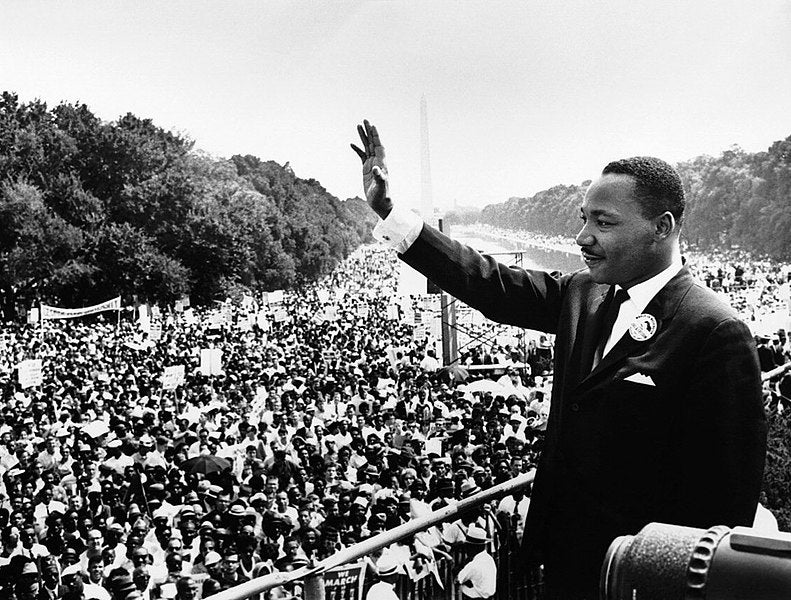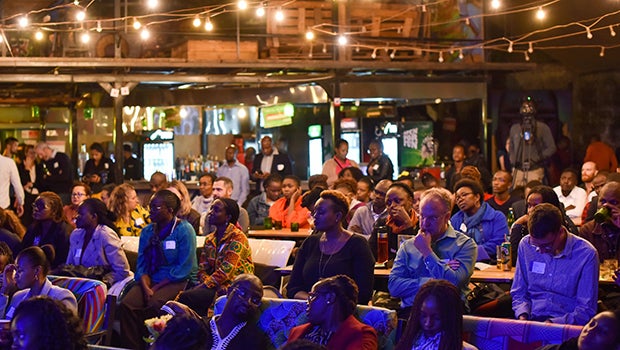Former NAACP Chairman Julian Bond speaks to an audience of Aspen Wye Fellows at the Aspen Institute River House. Photo by George Hatcher
The Aspen Wye Fellows recently hosted civil rights pioneer and Chairman Emeritus of the NAACP Board of Directors Julian Bond for a dialogue at the Aspen Institute River House in Queenstown, Maryland. Speaking to nearly 100 Fellows and guests, the famed social activist, politician, professor, and writer discussed the history and progress of the civil rights movement.
The Distinguished Scholar in the School of Government at American University and Professor Emeritus in History at the University of Virginia noted that President Obama’s election led many to believe that racial disparity is no longer an issue for our country, but said that while it was a sign of progress, it has not eliminated racist attitudes or structural inequality.
Professor Bond fervently explained that this past half century since segregation could not simply erase 300 years of slavery or profound legal discrimination. The audience was challenged to engage in an intimate discussion with him to question their own assumptions and examine the context of their own experiences. An abbreviated version of Professor Bond’s remarks from the evening can be found below:
For most of my adult life, I have been engaged in what once was called “race work” — fighting to make justice and fairness a reality for everyone. The racial picture in America has improved remarkably in my lifetime, so much so that a black man has been elected and re-elected President of the United States, an unthinkable development just a few years ago.
But paradoxically, Barack Obama’s victory in 2008 convinced many that all racial barriers and restrictions had been vanquished and we had entered racial nirvana across the land. This was just one of the many unfair burdens placed on Obama’s presidency. We knew that his victory did not herald a post-civil rights America or mean that race had been vanquished. It could not eliminate structural inequity or racist attitudes.
Indeed, there is evidence that it fomented them. Obama is to the Tea Party as the moon is to werewolves.
Those who say that ‘race is history’ have it exactly backward — history is race.
The word ‘America’ scrambled, after all, spells ‘I am race.’
And America is race — from its symbolism to its substance, from its founding by slaveholders to its rending by the Civil War, from Johnnie Reb to Jim Crow, from the Ku Klux Klan to Katrina, from Emmett Till to Trayvon.
This is the third year of the sesquicentennial of the Civil War, the war that claimed more American lives than all other wars combined in our nation’s history. That it is occurring during the presidency of the first black person to hold his country’s highest office is only one of many ironies that abound.
Then, General Robert E. Lee wrote:
“The blacks are immeasurably better off than in Africa, morally, physically and socially. The painful discipline they are undergoing is necessary for their further instruction as a race and will prepare them, I hope, for better things.”
Last March, at the Conservative Political Action Conference (CPAC), an audience member echoed Lee, praising slaveholders “for feeding” and “housing” African-Americans when they were slaves. Members of the audience cheered. And this was during a ‘minority outreach panel!’ (Scott Keyes and Zack Beauchamp, “CPAC Participant Defends Slavery at Minority Outreach Panel”, Think Progress, March 15, 2013)
When the Civil War ended, Southerners viewed the Republicans as an abolitionist party. Today they embrace it as the white people’s party. Then, opponents regarded Lincoln’s election as intolerable. Today, they feel that way about President Obama’s.
 I recently read an entry from a Civil War diarist, Lucy Rebecca Buck, a supporter of the Confederacy. She was 20 years old and living with her family in Virginia when she wrote, “We shall never any of us be the same as we have been.”
I recently read an entry from a Civil War diarist, Lucy Rebecca Buck, a supporter of the Confederacy. She was 20 years old and living with her family in Virginia when she wrote, “We shall never any of us be the same as we have been.”
Obama’s election had this effect on us as a people. We knew, from day one, that “we shall never any of us be the same as we have been.”
But that meant radically different things to different people. For many, it represented America living up to its ideals: sweet land of liberty, where all men are created equal. For others, it threatened the end of the “real” America they knew and loved — heterosexual, Christian, male, white.
As one study of the Tea Party movement concluded:
“Tea Party supporters actually wish to turn the clock back. They hope to return to a point in American life before Barack Obama held the highest office in the land, before a Latina was elevated to the Supreme Court, and when powerful members of Congress were all
heterosexual… .” (Christopher S. Parker and Matt A. Barreto, “Change They Can’t Believe In: The Tea Party and Reactionary Politics in America,” Princeton University Press, 2013).
Obama, you will recall, launched his 2008 presidential campaign in Lincoln’s hometown of Springfield, Illinois, and took the oath of office with his left hand on Lincoln’s Bible. Ironically, Obama carried every state that Lincoln won 148 years earlier. But the legacy of slavery and the Civil War colored the state-by-state results. In every state that was part of the Confederacy, John McCain won a larger share of the white vote than he did nationwide, including almost 90 percent in both Alabama and Mississippi.
Similarly, Romney won the Presidency of the Confederate States of America, having carried 9 of the 11 traitor states. He achieved his highest share of the white vote in the state with the highest percentage of black voters — Mississippi. “Indeed, Romney’s strong national showing among white voters was almost exclusively driven by historic support from Southern and Appalachian white voters.” (Nat Cohn, “Winning More White Voters Won’t Save the GOP, New Republic, July 9, 2013)
A 2011 Pew Research Center poll found that a majority of white southerners think it is appropriate for today’s politicians to praise Confederate leaders, the only demographic to subscribe to this belief. Another poll done by CNN found that an astounding four in ten southern whites sympathize more with the Confederacy than with the Union.
More recently, and more disturbingly, an AP survey done right before the 2012 election concluded:
“In all, 51 percent of Americans now express explicit anti-black attitudes … The number of Americans with anti-black sentiments jumped 56 percent, up from 49 percent during the last presidential election.” (Charles Blow, “Escaping Slavery”, The New York Times online, January 4, 2013).
As political scientist Thomas Schaller notes: “[T]he partisan impact of racial attitudes in the South is stronger today than in the past.” (Thomas Schaller, Whistling Past Dixie , 2006).
Our response to the nation’s first black president during the Civil War’s anniversary confirms that we are still a country at war with itself. But we are not the same country. We have gone from Civil War to civil rights.
In 1961, when the nation observed the Civil War’s centennial, the civil rights movement was gaining momentum, as was Martin Luther King.
It was only 6 years earlier, during the Montgomery Bus Boycott, that King had been introduced to the nation and the world. He was 26 years old. At that early age and at that early stage of the boycott, King understood how historic it would be. Four days after Rosa Parks stood up for justice by sitting down, the boycott began. That evening, at the first mass meeting, King declared:
“… When the history books are written in the future, somebody will have to say, ‘there lived a race of people, a black people … who had the moral courage to stand up for their rights. And thereby they injected a new meaning into the veins of history and civilization.’” (Martin Luther King, Jr. “MIA Mass Meeting at Holt Street Baptist Church,” December 5, 1955)
In 1963 alone, the year that King — fresh from the battlefields of Birmingham — told the nation of his dream at the March on Washington, there were more than 10,000 anti-racist demonstrations. The result was the enactment of the 1964 Civil Rights Act – the most sweeping civil rights legislation before or since and one of Congress’ finest hours.
We look back on the years between Montgomery in 1955 and the passage of the Voting Rights Act in 1965 with some pride.
Those were the days when politicians from both parties supported the struggle for civil rights. Now they struggle to be civil.
Those were the days when banks loaned money to people, and not like these days when the people lend money to banks.
Those were the days when we were powered by our values, and not valued for our power.
Those were the days when good music was popular and popular music was good.
Those were the days when the President picked the Supreme Court and not the other way around.
Those were the days when we had a war on poverty, not a war on the poor.
Those were the days when voters chose their politicians, unlike today when self-serving gerrymandering and political manipulation allow politicians to choose their voters.
Those were the days when the news media really was “fair and balanced” and not just mouthpieces for the misinformed. (“Voters Say Election Full of Misleading and False Information,” The University of Maryland’s World Public Opinion survey, December 9, 2010.)
But those were not “the good old days.”
In those days, “[t]he law, the courts, the schools, and almost every institution … favored whites. This was white supremacy.” (Franklin, John Hope & Alfred Moss, Jr., From Slavery to Freedom; 12th ed.)
When the Supreme Court announced in May 1955, in the second Brown decision, that the white South could make haste slowly in dismantling segregated schools, I was a year older than Emmett Till.
His murder three months after the second Brown decision was more immediate to me than the Court’s pronouncements had been. We were nearly the same age when he was killed, in Money, Mississippi, for whistling at a white woman. Emmett Till’s death terrified me. But in the fall of 1957 a group of black teenagers encouraged me to put that fear aside. These young people — the nine young women and men who integrated Little Rock’s Central High School — set a high standard of grace and courage under fire as they dared the mobs who surrounded their school.
Here, I thought, is what I hope I can be, if ever the chance comes my way.
The chance to test and prove myself did come my way in 1960, as it came to thousands of other black high school and college students across the South, in a mobilization of young black people not duplicated in our country before or since. First through the sit-ins, then in Freedom Rides, and then in voter registration and political organizing drives in the rural South, we joined an old movement against white supremacy that had deep, strong roots.
The NAACP’s founding in 1909 gave the movement an organized base. It soon developed an aggressive strategy of litigation aimed at striking down racial restrictions enshrined in law, triumphing in 1954 with Brown v. Board of Education, ending legal segregation in public schools. That decision effectively ended segregation’s legality; it also gave a nonviolent army license to challenge segregation’s morality as well. From Brown in 1954 forward, the movement expanded its targets, tactics, and techniques. Organizations and leadership expanded as well. When Martin Luther King came on the scene as the leader of the Montgomery Bus Boycott, he articulated a new method — nonviolent resistance — of fighting segregation.
The new method required direct action through mass participation. Reliance on slower appeals to courts began to subside. In this period, gains were won at lunch counters and movie theaters, bus stations and polling places, and the fabric of legal segregation came undone. That movement then was a second Reconstruction, whose ripples were felt far beyond the southern states and whose victories benefited more than blacks. Like the first Reconstruction, it saw gains for blacks extended to greater protections for others. Like the first, it gave new life to other movements of disadvantaged Americans. And like the first Reconstruction, the second ended when the national purpose wavered and reaction swept the land.
Before it slowed, it changed our country forever. A voteless people voted with their bodies and their feet and paved the way for other social protest. The anti-war movement of the l960s drew its earliest soldiers from the southern freedom army. The reborn movement for women’s rights took many of its cues and much of its momentum from the southern movement for civil rights. The movement’s origins were in a bitter struggle for elemental civil rights, but it largely became, in the post-segregation era, a movement for political and economic power, and today black women and men hold office and wield power in numbers we only dreamed of before.
But despite impressive increases in the numbers of black people holding public office, despite our ability to sit and eat and ride and vote and attend school and live in places that used to bar black faces, in some important ways nonwhite Americans face problems more difficult to attack now than in the years that went before. We are such a young nation so recently removed from slavery that only my father’s generation stands between Julian Bond and human bondage. Like many others, I am the grandson of a slave.
My grandfather, James Bond, was born in 1863, in Kentucky; freedom didn’t come for him until the 13th Amendment was ratified in 1865.
He and his mother were property, like a horse or a chair. As a young girl, she had been given away as a wedding present to a new bride, and when that bride became pregnant, her husband — that’s my great-grandmother’s owner and master — exercised his right to take his wife’s slave as his mistress.
That union produced two children, one of them my grandfather.
At age 15, barely able to read and write, he hitched his tuition — a steer — to a rope and walked across Kentucky to Berea College and the college took him in. My grandfather belonged to a transcendent generation of black Americans, a generation born into slavery, freed by the Civil War, determined to make their way as free women and men.
Martin Luther King belonged to another transcendent generation of black Americans, a generation born into segregation, freed from racism’s constraints by their own efforts, determined to make their way in freedom.
The Civil War that freed my grandfather was fought over whether blacks and whites shared a common humanity. Less than ten years after it ended, the nation chose sides with the losers and agreed to continue black repression for almost 100 years. The freed slaves found that their former masters once again controlled their fate.
American slavery was a human horror of staggering dimensions, a crime against humanity. The profits it produced endowed great fortunes and enriched generations, and its dreadful legacy embraces all of us today.
Two hundred and forty-six years of slavery were followed by 100 years of state-sanctioned discrimination, reinforced by public and private terror, ending only after a protracted struggle in 1965, two years after Barack Obama was born. If you are 45 years old or younger, it is only in your lifetime that racial equality before the law became a reality, not before.
For only roughly 45 years have all black Americans been granted the full rights of citizens, only 45 years since legal segregation was ended nationwide, only 45 years since the right to register and vote was universally guaranteed, only 45 years since the protections of the law and Constitution were officially extended to all.
We are now asked to believe that 200 years of being someone’s property, followed by 100 years of legal oppression in the South and discrimination in the North can be wiped away by four-and-a-half decades of half-hearted remediation and one black president.
We are now asked to believe that despite more than three centuries of horror, no permanent damage was done to the oppressors or the oppressed. We are asked to believe that we Americans are now a healed and whole people.
As one historian has observed, “The greatest impediment to achieving racial equality is the narcotic belief that we already have.” (Jelani Cobb,”Lincoln Died for Our Sins,” Washington Monthly, p. 2; Jan., Feb 2013)
The truth is that Jim Crow may be dead, but racism is alive and well. That is the central fact of life for every non-white American, including the President of the United States. It eclipses income, position, and education. Race trumps them all.
In his second inaugural address, Abraham Lincoln reflected on the war and its cause — slavery. Eric Foner writes:
“In essence, Lincoln asked the nation to confront unblinkingly the legacy of slavery. What were the requirements of justice in the face of this reality? What would be necessary to enable former slaves and their descendants to enjoy fully the pursuit of happiness? Lincoln did not live to provide an answer. A century and a half later, we have yet to do so.” (“The Emancipation of Abe Lincoln,” The New York Times, Jan. 1, 2013)
So we have work to do – none of it is easy, but we have never wished our way to freedom. Instead, we have always worked our way.
Today, we have much more to work with and we take heart that so much has changed. The changes that have come have everything to do with the work of the modern movement for civil rights. There needs to be a constantly growing and always reviving activist progressive movement across America if we are going to maintain and expand victories and our vision for the country.
We must not forget that Martin Luther King stood before and with thousands, the people who made the mighty movement what it was.
From Jamestown’s slave pens to Montgomery’s boycotted busses, these ordinary men and women labored in obscurity, and from Montgomery forward they provided the foot soldiers of the freedom army. They shared, with King, “an abiding faith in America.”
They walked in dignity, rather than ride in shame. They faced bombs in Birmingham and mobs in Mississippi. They sat down at lunch counters so others could stand up. They marched — and they organized.
King didn’t march from Selma to Montgomery by himself. He didn’t speak to an empty field at the March on Washington. There were thousands marching with him, and before him, and thousands more who did the dirty work that preceded the triumphal march.
The successful strategies of the modern movement for civil rights were litigation, organization, mobilization and coalition, all aimed at creating a national constituency for civil rights. Sometimes the simplest of deeds — sitting at a lunch counter, going to a new school, applying for a marriage license, casting a vote — can challenge the way we think and act.
Racial justice, economic equality, and world peace — these were the themes that occupied Martin King’s life; they ought to occupy ours today.
We have a long and honorable tradition of social justice in this country. It still sends forth the message that when we act together we can overcome.
My slave-born grandfather speaks to us today.
“Wrong” he said, “for a time may seem to prevail and the good already accomplished seem to be overthrown. But forward in the struggle, inspired by the achievements of the past, sustained by a faith that knows no faltering, forward in the struggle.” (“Commencement Address” by James Bond, Berea College Reporter; June, 1892).
Thank you.


